Liquid–Liquid Two-Phase Flow and Size Prediction of Slug Droplets in Microchannels
Abstract
:1. Introduction
2. Experimental Procedure
3. Results and Discussion
3.1. Flow Patterns of Liquid–Liquid Two-Phase
3.2. Flow Pattern Maps of Liquid–Liquid Two-Phase
3.3. Droplet Size of the Slug Flow
4. Conclusions
- (1)
- Three flow patterns were observed regardless of the configuration of the microchannel: slug flow, dripping flow, and jetting flow. Then, the flow pattern maps were presented based on the Reynolds number of the dispersed phase Red and the Capillary numbers of the continuous phase Cac. Importantly, it was found that the downstream orifice size of the microchannel had a momentous influence on the flow pattern of the liquid–liquid two-phase: with a decrease in the orifice size, there were shifts of the slug–dripping transition and dripping–jetting transition to lower Cac values. Meanwhile, the slug flow region decreased in area but the jetting flow region increased in area with the decrease in orifice size. Furthermore, a composite term of , and Reor(d), was adopted to form the universal flow map including the slug and dripping flow while the universal flow map including the dripping and the jetting flow was constructed based on and Reor(d).
- (2)
- The effects of the operating conditions on the droplet size of slug flow were investigated. It was ascertained that the dimensionless slug droplet size l/wc decreases with the increment of the flow rate of the continuous phase Qc and the flow rate ratio of the two-phase φ. Additionally, l/wc increases with the augmentation of the flow rate of the dispersed phase Qd and the orifice size wor. Meanwhile, l/wc decreases firstly and then remains nearly constant with the increase in the dimensionless number φ−1Cac, and the critical dimensionless number of the transition is about (φ−1Cac)cirt ≈ 0.01. The mechanisms of droplet formation in both regions were investigated: when φ−1Cac < 0.01, the droplet formation was mainly driven by the squeezing force Fp, while when φ−1Cac > 0.01, both the squeezing force Fp and the shear force Fτ contributed to the droplet formation, and the downstream orifice provided a stronger focusing effect in this region. Furthermore, the dimensionless slug droplet size could be predicted by the correlation equation with the flow rate ratio of the two-phase φ, the Capillary number of the continuous phase Cac, and the dimensionless orifice size wor/wc. When φ−1Cac < 0.01, the correlation could be expressed as ; when φ−1Cac > 0.01, the prediction formula was . The predicted results were in good agreement with the experimental values.
Author Contributions
Funding
Data Availability Statement
Conflicts of Interest
Nomenclature
| A | The cross-sectional area of the orifice, μm2 |
| B | The cross-sectional area of the gap between the forming droplet and the channel wall, μm2 |
| dh | Equivalent size of orifice section, μm |
| Fp | Squeezing force, (kg·m)/s2 |
| Fτ | Shear force, (kg·m)/s2 |
| h | Depth of the channel, μm |
| l | Length of the slug droplet, μm |
| lo | Length of the drop head, μm |
| lor | Length of the orifice of the microchannel, μm |
| L | Orifice perimeter, μm |
| n | Numbers of the slug droplet |
| ΔPc | Pressure drop of the continuous phase, Pa |
| Qd | Volumetric flow rate of dispersed phase, mL·h−1 |
| Qc | Volumetric flow rate of continuous phase, mL·h−1 |
| u | Superficial velocity of liquid, m·s−1 |
| wc | Width of the channel, μm |
| w0 | Width of the droplet head when the neck of the dispersed phase is initially formed, μm |
| wor | Width of the orifice of the channel, μm |
| Greek letters | |
| α | Parameter |
| β | Parameter |
| ε | the thickness of the fluid film, μm |
| μ | Viscosity of liquid, mPa·s |
| ρ | Density of liquid, kg·m−3 |
| σ | Surface tension of liquid, mN·m−1 |
| φ | The flow ratio of continuous phase to disperse phase (φ = Qc/Qd) |
| θ | Contact angle, ° |
| Dimensionless groups | |
| Ca | Capillary number (Ca = uμ/σ) |
| Oh | Ohnesorge number (Oh = μ/(ρσwc)1/2) |
| Re | Reynolds number (Re = ρwcu/μ) |
| We | Weber number (We = CaRe = ρwcu2/σ) |
| Subscripts | |
| c | Continuous phase |
| crit | Critical dimensionless number |
| d | Dispersed phase |
| exp | The experimental value (l/wc)pre of the dimensionless droplet size of slug flow |
| gap | Gap between the forming droplet and the channel wall |
| or | The orifice of the microchannel |
| pre | The predicted value (l/wc)pre of the dimensionless droplet size of the slug flow |
References
- Nehme, R.; Blel, W.; Montillet, A.; Bellettre, J.; Marchal, L. Production of oil in water emulsions in microchannels at high throughput: Evaluation of emulsions in view of cosmetic, nutraceutical or pharmaceutical applications. Chem. Eng. Process. Process Intensif. 2021, 161, 108301. [Google Scholar] [CrossRef]
- Stone, H.A.; Kim, S. Microfluidics basic issues, applications, and challenges. AIChE J. 2001, 47, 1250–1254. [Google Scholar] [CrossRef]
- Al-Azzawi, M.; Mjalli, F.S.; Husain, A.; Al-Dahhan, M. A Review on the Hydrodynamics of the Liquid-Liquid Two-Phase Flow in the Microchannels. Ind. Eng. Chem. Res. 2021, 60, 5049–5075. [Google Scholar] [CrossRef]
- Qian, J.Y.; Li, X.J.; Wu, Z.; Jin, Z.J.; Sunden, B. A comprehensive review on liquid-liquid two-phase flow in microchannel: Flow pattern and mass transfer. Microfluid. Nanofluidics 2019, 23, 116. [Google Scholar] [CrossRef]
- Cao, Z.; Wu, Z.; Sundén, B. Dimensionless analysis on liquid-liquid flow patterns and scaling law on slug hydrodynamics in cross-junction microchannels. Chem. Eng. J. 2018, 344, 604–615. [Google Scholar] [CrossRef]
- Cubaud, T.; Mason, T.G. Capillary threads and viscous droplets in square microchannels. Phys. Fluids 2008, 20, 053302. [Google Scholar] [CrossRef]
- Wang, C.L.; Tian, M.C.; Zhang, J.Z.; Zhang, G.M. Experimental study on liquid–liquid two-phase flow patterns and plug hydrodynamics in a small channel. Exp. Therm. Fluid Sci. 2021, 129, 110455. [Google Scholar] [CrossRef]
- Ma, H.Y.; Zhao, Q.K.; Yao, C.Q.; Zhao, Y.C.; Chen, G.W. Effect of fluid viscosities on the liquid-liquid slug flow and pressure drop in a rectangular microreactor. Chem. Eng. Sci. 2021, 241, 116697. [Google Scholar] [CrossRef]
- Fu, T.T.; Wu, Y.N.; Ma, Y.G.; Li, H.Z. Droplet formation and breakup dynamics in microfluidic flow-focusing devices: From dripping to jetting. Chem. Eng. Sci. 2012, 84, 207–217. [Google Scholar] [CrossRef]
- Kovalev, A.V.; Yagodnitsyna, A.A.; Bilsky, A.V. Viscosity Ratio Influence on Liquid-Liquid Flow in a T-shaped Microchannel. Chem. Eng. Technol. 2020, 44, 365–370. [Google Scholar] [CrossRef]
- Zhang, Q.; Liu, H.C.; Zhao, S.N.; Yao, C.Q.; Chen, G.W. Hydrodynamics and mass transfer characteristics of liquid–liquid slug flow in microchannels: The effects of temperature, fluid properties and channel size. Chem. Eng. J. 2019, 358, 794–805. [Google Scholar] [CrossRef]
- Yagodnitsyna, A.A.; Kovalev, A.V.; Bilsky, A.V. Flow patterns of immiscible liquid-liquid flow in a rectangular microchannel with T-junction. Chem. Eng. J. 2016, 303, 547–554. [Google Scholar] [CrossRef]
- Shin, H.C.; Senguttuvan, S.; Kim, S.M. Experimental study on sub-regimes of air-water slug flow in a rectangular micro-channel. Int. J. Mech. Sci. 2023, 259, 108577. [Google Scholar] [CrossRef]
- Bordbar, A.; Kheirandish, S.; Taassob, A.; Kamali, R.; Ebrahimi, A. High-viscosity liquid mixing in a slug-flow micromixer: A numerical study. J. Flow Chem. 2020, 10, 449–459. [Google Scholar] [CrossRef]
- Etminan, A.; Muzychka, Y.S.; Pope, K. A review on the hydrodynamics of Taylor flow in microchannels: Experimental and computational studies. Processes 2021, 9, 870. [Google Scholar] [CrossRef]
- Talimi, V.; Muzychka, Y.S.; Kocabiyik, S. A review on numerical studies of slug flow hydrodynamics and heat transfer in microtubes and microchannels. Int. J. Multiph. Flow 2012, 39, 88–104. [Google Scholar] [CrossRef]
- Etminan, A.; Muzychka, Y.S.; Pope, K. Liquid film thickness of two-phase slug flows in capillary microchannels: A review paper. Can. J. Chem. Eng. 2021, 100, 325–348. [Google Scholar] [CrossRef]
- Roumpea, E.; Kovalchuk, N.M.; Chinaud, M.; Nowak, E.; Simmons, M.J.H.; Angeli, P. Experimental studies on droplet formation in a flow-focusing microchannel in the presence of surfactants. Chem. Eng. Sci. 2019, 195, 507–518. [Google Scholar] [CrossRef]
- Lei, L.; Zhao, Y.T.; Chen, W.K.; Li, H.L.; Wang, X.Y.; Zhang, J.Z. Experimental studies of droplet formation process and length for liquid–liquid two-phase flows in a microchannel. Energies 2021, 14, 1341. [Google Scholar] [CrossRef]
- Zhao, N.; Long, W.; He, Y.Q. Dynamic behavior and driving force model of droplet formation in a T-junction microchannel. J. Micromech. Microeng. 2019, 29, 115002. [Google Scholar]
- Thorsen, T.; Roberts, R.W.; Arnold, F.H.; Quake, S.R. Dynamic pattern formation in a vesicle-generating microfluidic device. Phys. Rev. Lett. 2001, 86, 4163–4166. [Google Scholar] [CrossRef] [PubMed] [Green Version]
- Garstecki, P.; Fuerstman, M.J.; Stone, H.A.; Whitesides, G.M. Formation of droplets and bubbles in a microfluidic T-junction-scaling and mechanism of break-up. Lab Chip 2006, 6, 437–446. [Google Scholar] [CrossRef] [PubMed]
- Xu, J.H.; Li, S.W.; Tan, J.; Luo, G.S. Correlations of droplet formation in T-junction microfluidic devices: From squeezing to dripping. Microfluid. Nanofluid. 2008, 5, 711–717. [Google Scholar] [CrossRef]
- Tsaoulidis, D.; Angeli, P. Effect of channel size on liquid-liquid plug flow in small channels. AIChE J. 2016, 62, 315–324. [Google Scholar] [CrossRef] [Green Version]
- Wu, L.Y.; Liu, X.D.; Zhao, Y.J.; Chen, Y.P. Role of local geometry on droplet formation in axisymmetric microfluidics. Chem. Eng. Sci. 2017, 163, 56–67. [Google Scholar] [CrossRef]
- Korczyk, P.M.; van Steijn, V.; Blonski, S.; Zaremba, D.; Beattie, D.A.; Garstecki, P. Accounting for corner flow unifies the understanding of droplet formation in microfluidic channels. Nat. Commun. 2019, 10, 2528. [Google Scholar] [CrossRef] [Green Version]
- Du, W.; Fu, T.T.; Zhang, Q.D.; Zhu, C.Y.; Ma, Y.G.; Li, H.Z. Breakup dynamics for droplet formation in a flow-focusing device: Rupture position of viscoelastic thread from matrix. Chem. Eng. Sci. 2016, 153, 255–269. [Google Scholar] [CrossRef]
- Zhang, Q.D.; Fu, T.T.; Zhu, C.Y.; Ma, Y.G. Formation and size prediction of slug droplet in viscoelastic fluid in flow-focusing microchannel. CIESC J. 2016, 67, 504–511. [Google Scholar]
- Carrier, O.; Ergin, F.G.; Li, H.Z.; Watz, B.B.; Funfschilling, D. Time-resolved mixing and flow-field measurements during droplet formation in a flow-focusing junction. J. Micromech. Microeng. 2015, 25, 084014. [Google Scholar] [CrossRef]
- Fatehifar, M.; Revell, A.; Jabbari, M. Non-Newtonian Droplet Generation in a Cross-Junction Microfluidic Channel. Polymers 2021, 13, 1915. [Google Scholar] [CrossRef]
- Song, Q.; Yang, Z.; Chen, Y.; Luo, X.L.; Chen, J.Y.; Liang, Y.Z. Effect of local geometry on droplet formation in flow-focusing microchannel. CIESC J. 2020, 71, 1540–1553. [Google Scholar]
- Christopher, G.F.; Noharuddin, N.N.; Taylor, J.A.; Anna, S.L. Experimental observations of the squeezing-to-dripping transition in T-shaped microfluidic junctions. Phys. Rev. E 2008, 78, 036317. [Google Scholar] [CrossRef]
- Du, W.; Fu, T.T.; Duan, Y.F.; Zhu, C.Y.; Ma, Y.G.; Li, H.Z. Breakup dynamics for droplet formation in shear-thinning fluids in a flow-focusing device. Chem. Eng. Sci. 2018, 176, 66–76. [Google Scholar] [CrossRef]
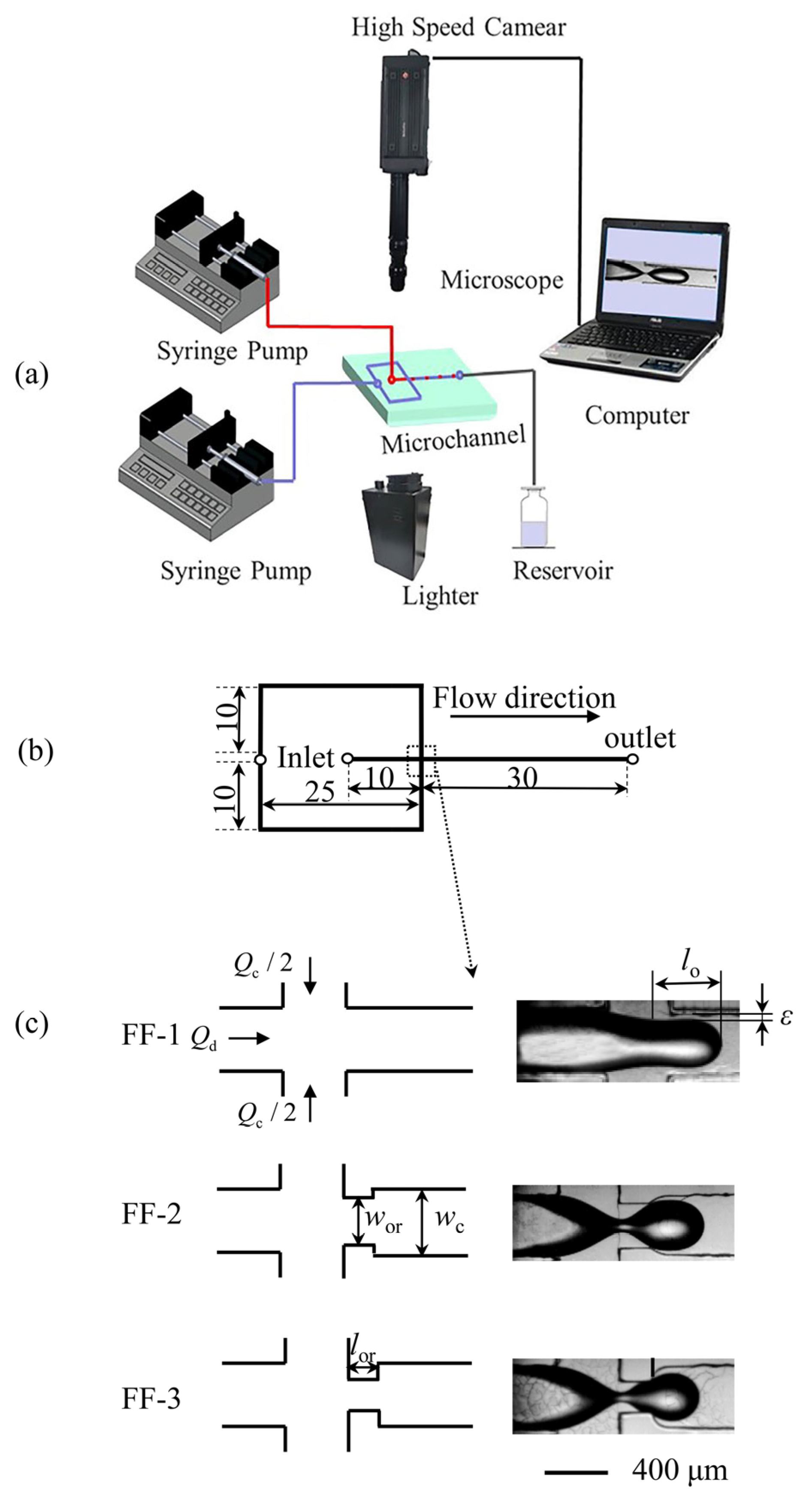
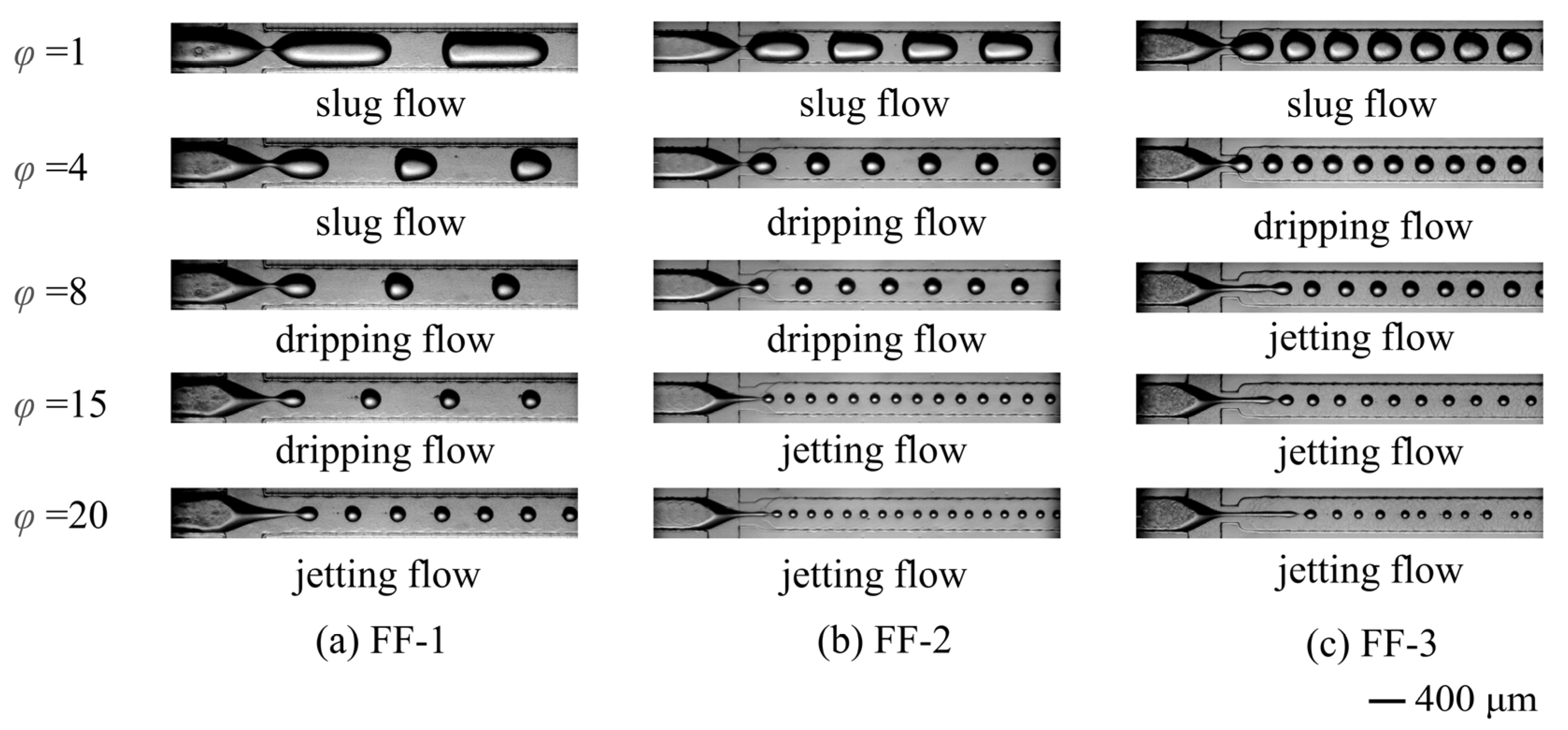
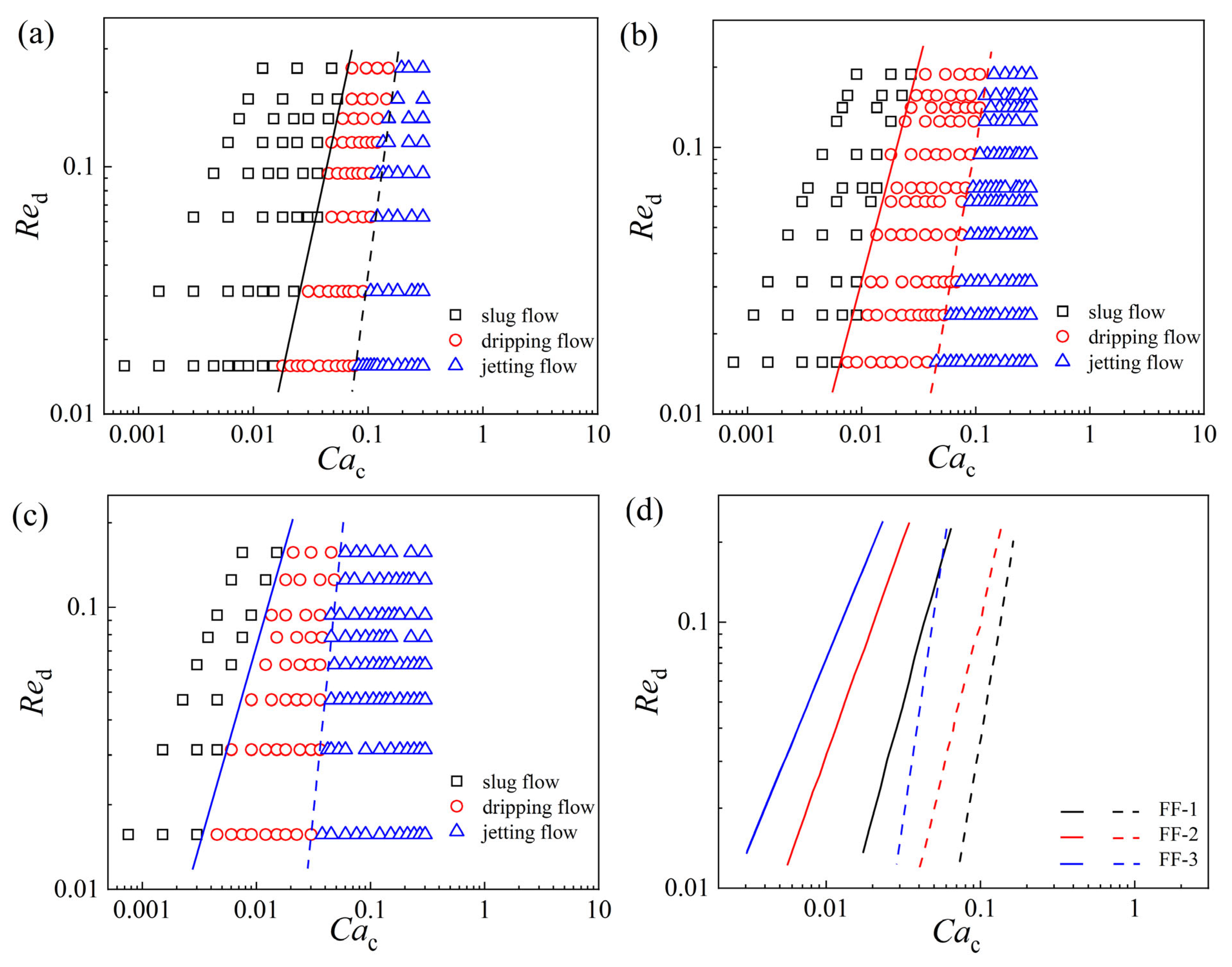

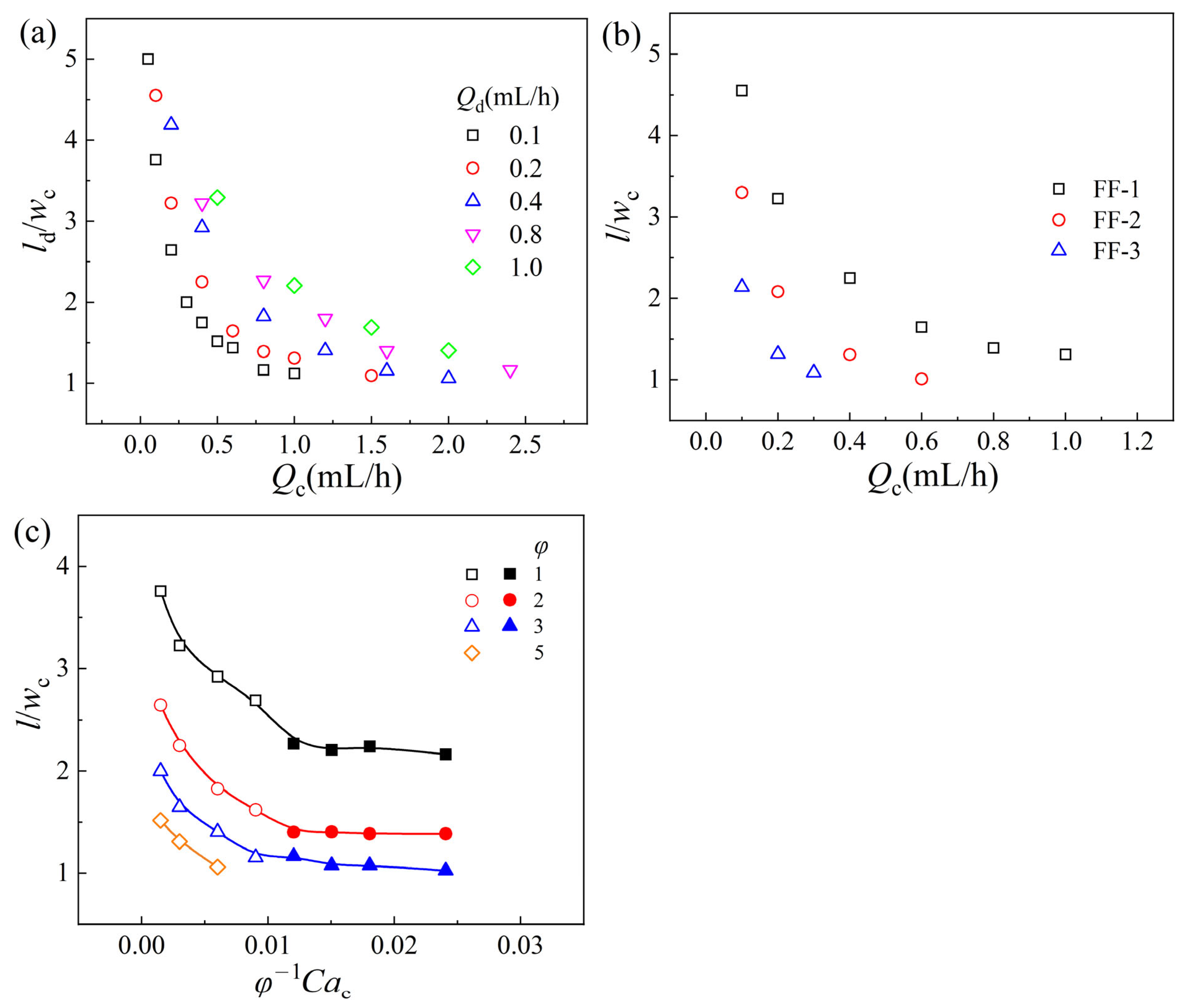
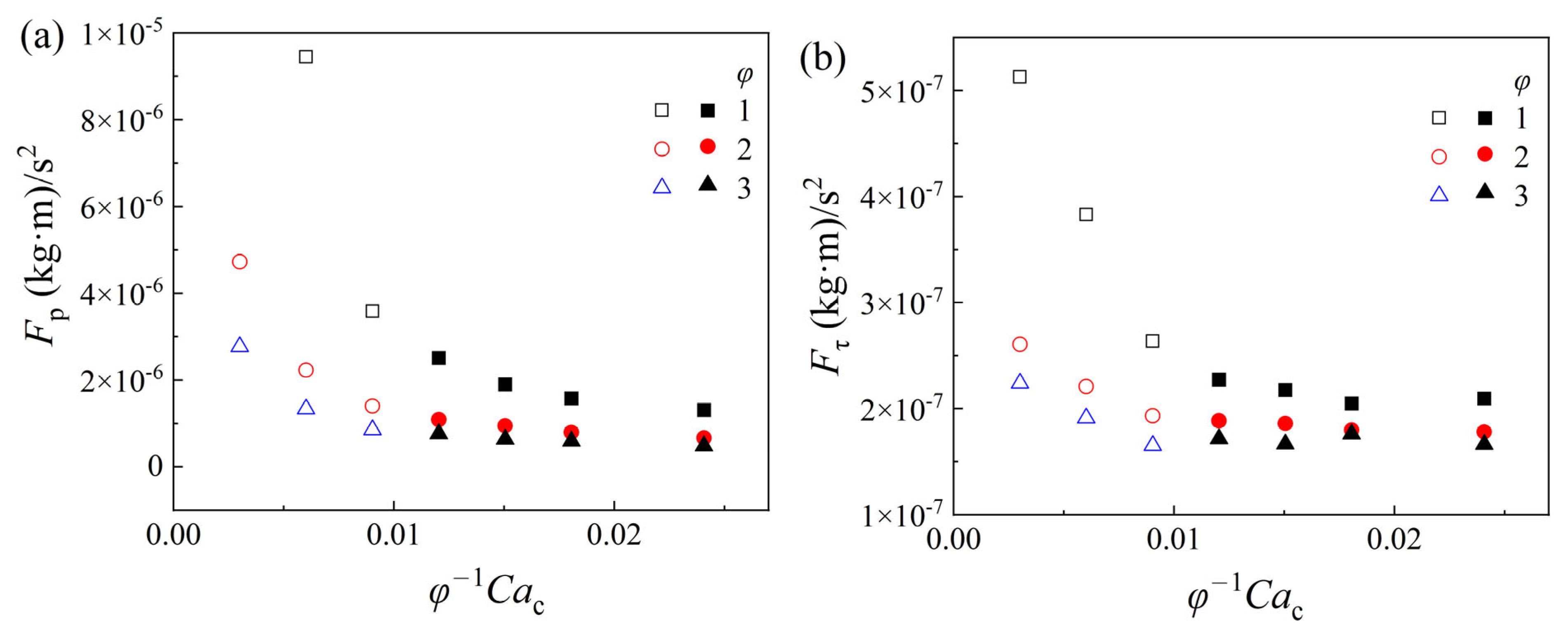
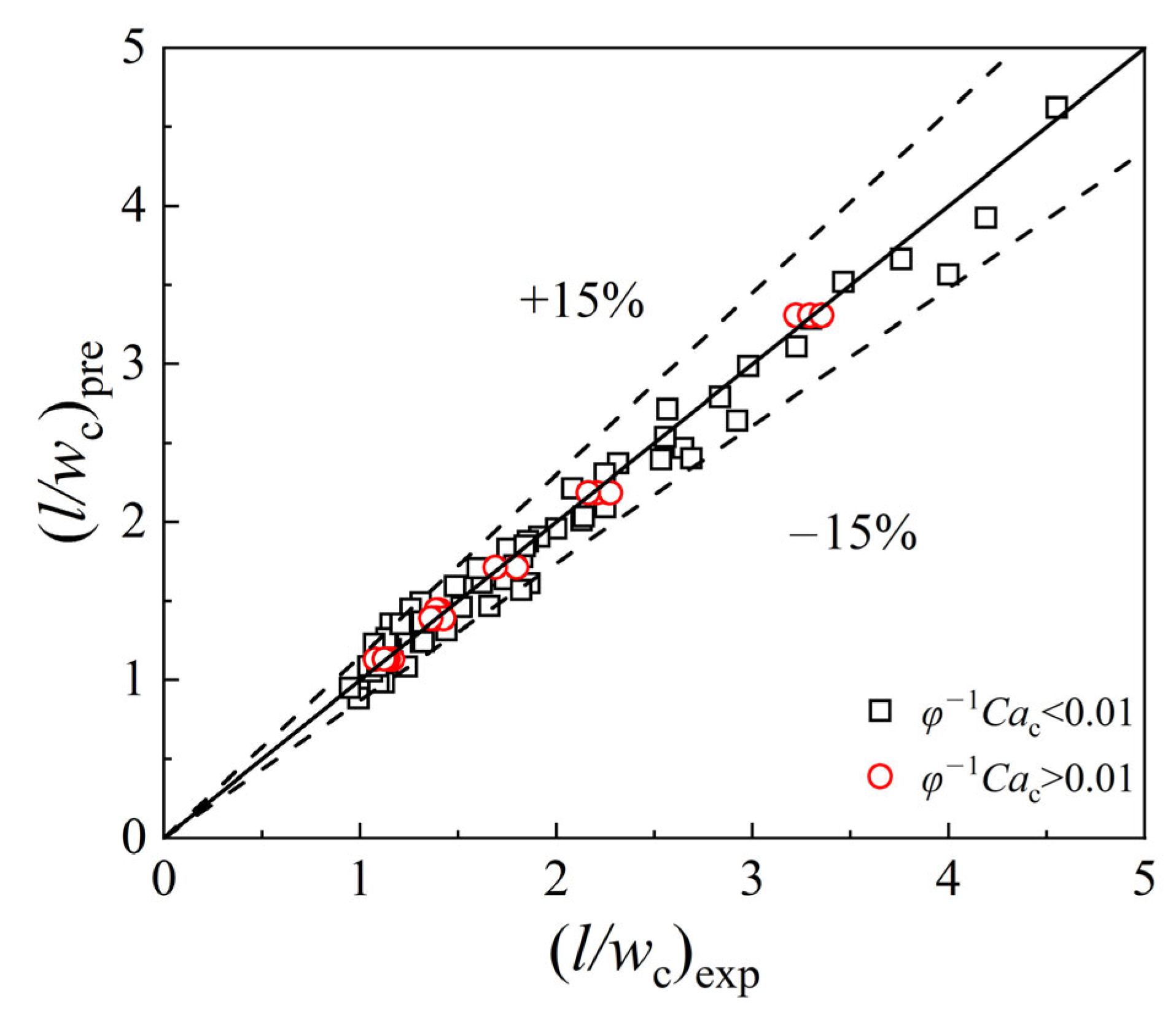
Disclaimer/Publisher’s Note: The statements, opinions and data contained in all publications are solely those of the individual author(s) and contributor(s) and not of MDPI and/or the editor(s). MDPI and/or the editor(s) disclaim responsibility for any injury to people or property resulting from any ideas, methods, instructions or products referred to in the content. |
© 2023 by the authors. Licensee MDPI, Basel, Switzerland. This article is an open access article distributed under the terms and conditions of the Creative Commons Attribution (CC BY) license (https://creativecommons.org/licenses/by/4.0/).
Share and Cite
Du, W.; Duan, Y.; Wang, L.; Liu, D. Liquid–Liquid Two-Phase Flow and Size Prediction of Slug Droplets in Microchannels. Processes 2023, 11, 2390. https://doi.org/10.3390/pr11082390
Du W, Duan Y, Wang L, Liu D. Liquid–Liquid Two-Phase Flow and Size Prediction of Slug Droplets in Microchannels. Processes. 2023; 11(8):2390. https://doi.org/10.3390/pr11082390
Chicago/Turabian StyleDu, Wei, Yingfeng Duan, Lina Wang, and Dayu Liu. 2023. "Liquid–Liquid Two-Phase Flow and Size Prediction of Slug Droplets in Microchannels" Processes 11, no. 8: 2390. https://doi.org/10.3390/pr11082390



